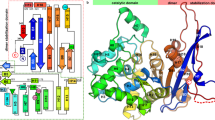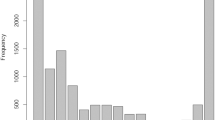Abstract
The Rhizobiaceae family of bacteria is characterized by the ability to form cortical hypertrophies on plants, and the ability to re-isolate the bacteria from these galls or nodules1.This family includes the genera Rhizobium, Bradyrhizobium, Agrobacterium and Phyllobactenum. Another unique feature of these bacteria is that they contain two forms of the enzyme glutamine synthetase, termed GSI and GSII2,3.GSI is typical of prokaryotic glutamine synthetases with respect to enzyme structure, the modulation of activity by post-translational modification, immunological cross-reactivity, and amino-acid sequence2,4,5.By contrast, GSII is distinct from all other known prokaryotic glutamine synthetases in structure and immunological reactivity, and is not known to be post-translationally modified. In these respects GSII is similar to eukaryotic glutamine synthetases6. We have isolated and characterized the gene encoding GSII, which we term glnII, from Bradyrhizobium japonicum, the soybean symbiont. We show here that the amino-acid sequence of GSII, as inferred from the gene sequence, is highly homologous to plant glutamine synthetases, suggesting that this bacterial gene is of eukaryotic origin.
This is a preview of subscription content, access via your institution
Access options
Subscribe to this journal
Receive 51 print issues and online access
$199.00 per year
only $3.90 per issue
Buy this article
- Purchase on Springer Link
- Instant access to full article PDF
Prices may be subject to local taxes which are calculated during checkout
Similar content being viewed by others
References
Jordan, D. C. in Bergey's Manual of Systematic Bacteriology Vol. 1, 234–242 (ed. Drieg, N. R.) (Williams & Wilkins, Baltimore, 1984).
Darrow, R. A. & Knotts, R. R. Biochem. biophys. Res. Commun. 78, 554–559 (1977).
Fuchs, R. L. & Keister, D. L. J. Bact. 144, 641–648 (1980).
Tronick, S. R., Chardi, J. E. & Stadtman, E. R. J. Bact. 115, 858–868 (1973).
Carlson, T. A., Guerinot, M. L. & Chelm, B. K. J. Bact. 162, 698–703 (1985).
DeVries, G. E., Oosterwijk, E. & Kijne, J. W. Pl. Sci. Lett. 32, 333–341 (1983).
Friedman, A. M., Long, S. R., Brown, S. E., Buikema, W. J. & Ausubel, F. M. Gene 18, 289–296 (1982).
Adams, T. H., McClung, C. R. & Chelm, B. K. J. Bact. 159, 857–862 (1984).
Whitehead, A. S., Goldberger, G., Woods, D. E., Markham, E. F. & Colten, H. R. Proc. natn. Acad. Sci. U.S.A. 80, 5387–5391 (1983).
Wood, W. I., Gitschier, J., Lasky, L. A. & Lawn, R. M. Proc. natn. Acad. Sci. U.S.A. 82, 1585–1588 (1985).
Southern, E. M. J. molec. Biol. 98, 503–517 (1975).
Bolivar, F. et al. Gene 2, 95–113 (1977).
Fisher, R., Tuli, R. & Haselkorn, R. Proc. natn. Acad. Sci. U.S.A. 78, 3393–3397 (1981).
Darrow, R. A. in Glutamine Synthetase: Metabolism, Enzymology and Regulation, 139–166 (eds Mora, J. & Palacios, R.) (Academic, New York, 1980).
Tumer, N. E., Robinson, S. J. & Haselkorn, R. Nature 306, 337–342 (1983).
Gebhardt, C., Oliver, J., Forde, B. G., Saarelainen, R. & Miflin, B. EMBO J. (in the press).
Pustell, J. & Kafatos, F. C. Nucliec Acids Res. 12, 643–655 (1984).
Lipman, D. J. & Pearson, W. R. Science 227, 1435–1441 (1985).
Bannister, J. V. & Parker, M. W. Proc. natn. Acad. Sci. U.S.A. 82, 149–152 (1985).
Dunlap, P. V. & Steinman, H. M. J. Bact. 165, 393–398 (1986).
Tischer, E., DasSarma, S. & Goodman, H. M. EMBO J. (in the press).
Darrow, R. A. et al. in Current Perspectives in Nitrogen Fixation, 182–185 (eds Gibson, H. H. & Newton, W. E.) (Australian Academy of Sciences, Canberra 1981).
Bender, R. A. et al. J. Bact. 129, 1001–1009 (1977).
Maxam, A. M. & Gilbert, W. Meth. Enzym. 65, 499–580 (1980).
Sanger, F., Nicklen, S. & Coulson, A. R. Proc. natn. Acad. Sci. U.S.A. 74, 5463–5467 (1977).
Deininger, P. L. Analyt. Biochem. 129, 216–223 (1983).
Norrander, J., Kemp, T. & Messing, J. Gene 26, 101–106 (1983).
Miller, J. H. Experiments in Molecular Genetics (Cold Spring Harbor Laboratory; New York, 1972).
Author information
Authors and Affiliations
Rights and permissions
About this article
Cite this article
Carlson, T., Chelm, B. Apparent eukaryotic origin of glutamine synthetase II from the bacterium Bradyrhizobium japonicum. Nature 322, 568–570 (1986). https://doi.org/10.1038/322568a0
Received:
Accepted:
Issue Date:
DOI: https://doi.org/10.1038/322568a0
This article is cited by
-
The Probability of a Horizontal Gene Transfer from Roundup Ready® Soybean to Root Symbiotic Bacteria: A Risk Assessment Study on the GSF Lysimeter Station
Water, Air, & Soil Pollution: Focus (2008)
-
Horizontal gene transfer in plants, a biohazard? Outcome of a literature review
Euphytica (1994)
Comments
By submitting a comment you agree to abide by our Terms and Community Guidelines. If you find something abusive or that does not comply with our terms or guidelines please flag it as inappropriate.



